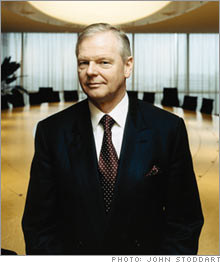Europe Businessman of the Year: Gerard KleisterleePhilips CEO Gerard Kleisterlee had a bright idea: sell off the volatile semiconductor business, rebrand the sleepy Dutch giant, and change the corporate culture. It's working.(Fortune Magazine) -- In this merger-mad age it's no big deal for a CEO to sell off a division or two. It's another story entirely if that division is his corporation's second-most-valuable unit, one where his father worked for decades and which the CEO himself describes as "the heart of the company." But that's exactly what Gerard Kleisterlee of Philips did last summer when he sold the Dutch conglomerate's semiconductor business to private-equity buyers for more than $10 billion, using the proceeds to focus on faster-growing lines like lighting and medical devices and to answer the prayers of Wall Street with a multibillion-dollar share buyback.
In one masterstroke, Kleisterlee took a giant step toward accomplishing what his predecessors in the top job at Philips had talked about but never done: transform a sleepy European electronics company with mediocre margins into a consumer-oriented powerhouse capable of producing both strong earnings gains and consistent returns for investors. The job is far from finished - "We're a little bit beyond halfway there," Kleisterlee says, sitting in his spare Amsterdam office on a foggy morning shortly before Christmas. But shareholders are already applauding, sending Philips (Charts) stock up more than 30 percent over the past six months to its highest levels since the tech bubble burst. Now, he says, the heat is on to show that this isn't just one more half-finished turnaround effort that ultimately runs out of steam. The coming year, he offers, "will open a new chapter as important as the one we closed in 2006. We must see the results coming through in sustained profitable growth and in making smart, sensible acquisitions." Cleaning house For most big companies, growing profits and making acquisitions are business as usual. But until recently Philips wasn't like most big companies. A huge, unwieldy conglomerate that makes everything from familiar light bulbs and electric shavers to less-well-known products like defibrillators and MRI machines, Philips at one time was even in the music business, with artists like Sting and Elton John recording on its PolyGram label. No wonder the company left even the analysts assigned to cover it scratching their heads. "Can You Tell What It Is Yet?" asked Citigroup's Simon Smith a year ago in a report on Philips that, despite its title, touted the company as "one of the last great misunderstood conglomerates of Europe." Now, with the sale of the semiconductor business and the division of the company into four easy-to-understand units - medical, lighting, consumer electronics and domestic appliances - Kleisterlee has seemingly cut through the Gordian knot. "Before Kleisterlee, the management of Philips had absolutely no credibility - its only commitment was to the status quo," says Philippe Brugere, manager of the Franklin Mutual European fund and a longtime holder of the stock. "Not only did Kleisterlee make it clear to the Street what he wanted to do, but he actually did it. He has made a profound change in the way this company is run." Indeed, what Kleisterlee is well on his way to doing - and why he has earned our Europe Businessman of the Year accolade - is to make a giant of old Europe competitive again in a world largely dominated by rivals in the U.S. and Asia. Kleisterlee makes an unlikely revolutionary. The 60-year-old engineer has spent his entire career at Philips, which was founded in the drab Dutch city of Eindhoven in 1891 by the Philips brothers, Anton and Gerard, as a light bulb maker. He studied electrical engineering at Eindhoven Technical University on a scholarship from Philips, where his father was a group leader in one of the company's earliest semiconductor factories in nearby Nijmegen. He flirted with joining a German semiconductor company (he speaks Dutch, German and English fluently, along with decent French), but decided to remain in Eindhoven after graduation, starting in Philips's medical division in 1974. After working his way up through the professional audio and components divisions and making his mark heading Philips's operations in Taiwan and China, Kleisterlee returned to Amsterdam and became chief operating officer in 2000. By the time he took over as CEO in the spring of 2001, the tech bubble was bursting. But at Philips, Kleisterlee says, the focus was still on "high-volume consumer electronics, semiconductors and components." What followed was a tidal wave of red ink - Kleisterlee calls it "the years of all hands on deck in order to cope with the biggest losses in the history of the company." Although Philips's future wasn't in doubt, its shares plunged from nearly $60 in 2001 to $13 in 2002, the semiconductor division leading the way down as sales fell 30 percent in two years. When tech recovered in 2003 and 2004, the performance of Philips's semiconductor unit also rebounded, but Kleisterlee and other top managers were determined to shift the focus of investors to the company's more stable, predictable businesses such as specialized lighting and complex medical devices, including MRIs and CT scanners, which boast margins of at least 12 percent but were overlooked by investors. |
|

